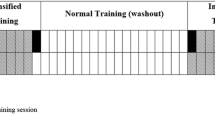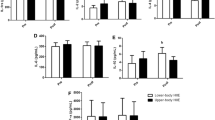Abstract
We investigated the influence of rectal temperature on the immune system during and after exercise. Ten well-trained male cyclists completed exercise trials (90 min cycling at 60% \( \ifmmode\expandafter\dot\else\expandafter\.\fi{V}{\text{O}}_{{2\max }} + \;{\kern 1pt} 16.1{\text{ - km}} \) time trial) on three separate occasions: once in 18°C and twice in 32°C. Twenty minutes after the trials in 32°C, the cyclists sat for ∼20 min in cold water (14°C) on one occasion, whereas on another occasion they sat at room temperature. Rectal temperature increased significantly during cycling in both conditions, and was significantly higher after cycling in 32°C than in 18°C (P < 0.05). Leukocyte counts increased significantly during cycling but did not differ between the conditions. The concentrations of serum interleukin (IL)-6, IL-8 and IL-10, plasma catecholamines, granulocyte-colony stimulating factor, myeloperoxidase and calprotectin increased significantly following cycling in both conditions. The concentrations of serum IL-8 (25%), IL-10 (120%), IL-1 receptor antagonist (70%), tumour necrosis factor-α (17%), plasma myeloperoxidase (26%) and norepinephrine (130%) were significantly higher after cycling in 32°C than in 18°C. During recovery from exercise in 32°C, rectal temperature was significantly lower in response to sitting in cold water than at room temperature. However, immune changes during 90 min of recovery did not differ significantly between sitting in cold water and at room temperature. The greater rise in rectal temperature during exercise in 32°C increased the concentrations of serum IL-8, IL-10, IL-1ra, TNF-α and plasma myeloperoxidase, whereas the greater decline in rectal temperature during cold water immersion after exercise did not affect immune responses.




Similar content being viewed by others
References
Argetsinger LS, Carter-Su C (1996) Mechanism of signaling by growth hormone receptor. Physiol Rev 76:1089–1107
Brenner IK, Severs YD, Shek PN, Shephard RJ (1996) Impact of heat exposure and moderate, intermittent exercise on cytolytic cells. Eur J Appl Physiol 74:162–171
Brenner IK, Zamecnik J, Shek PN, Shephard RJ (1997) The impact of heat exposure and repeated exercise on circulating stress hormones. Eur J Appl Physiol 76:445–454
Brenner IK, Castellani JW, Gabaree C, Young AJ, Zamecnik J, Shephard RJ, Shek PN (1999) Immune changes in humans during cold exposure: effects of prior heating and exercise. J Appl Physiol 87:699–710
Camus G, Nys M, Poortmans J, Venneman I, Monfils T, Deby-Dupont G, Juchmes-Ferir A, Deby C, Lamy M, Duchateau J (1998) Endotoxaemia, production of tumour necrosis factor alpha and polymorphonuclear neutrophil activation following strenuous exercise in humans. Eur J Appl Physiol 79:62–68
Chio CC, Chang YH, Hsu YW, Chi KH, Lin WW (2004) PKA-dependent activation of PKC, p38 MAPK and IKK in macrophage: implication in the induction of inducible nitric oxide synthase and interleukin-6 by dibutyryl cAMP. Cell Signal 16:565–575
Cross MC, Radomski MW, Vanhelder WP, Rhind SG, Shephard RJ (1996) Endurance exercise with and without a thermal clamp: effects on leukocytes and leukocyte subsets. J Appl Physiol 81:822–829
Curran-Everett D (2000) Multiple comparisons: philosophies and illustrations. Am J Physiol 279:R1–R8
Dill D, Costill D (1974) Calculation of percentage changes in volumes of blood, plasma, and red cells in dehydration. J Appl Physiol 37:247–248
Dogusan Z, Hooghe R, Verdood P, Hooghe-Peters EL (2001) Cytokine-like effects of prolactin in human mononuclear and polymorphonuclear leukocytes. J Neuroimmunol 120:58–66
Elenkov IJ, Chrousos GP (2002) Stress hormones, proinflammatory and antiinflammatory cytokines, and autoimmunity. Ann N Y Acad Sci 966:290–303
Ellis GS, Carlson DE, Hester L, He JR, Bagby GJ, Singh IS, Hasday JD (2005) G-CSF, but not corticosterone, mediates circulating neutrophilia induced by febrile-range hyperthermia. J Appl Physiol 98:1799–1804
Engel A, Knoll S, Kern P, Kern WV (2005) Interleukin-8 serum levels at fever onset in patients with neutropenia predict early medical complications. Infection 33:380–382
Foell D, Wittkowski H, Vogl T, Roth J (2007) S100 proteins expressed in phagocytes: a novel group of damage-associated molecular pattern molecules. J Leukoc Biol 81:28–37
Harrison C, Raftery M, Walsh J, Alewood P, Iismaa S, Thliveris S, Geczy C (1999) Oxidation regulates the inflammatory properties of the murine S100 Protein S100A8. J Biol Chem 274:8561–8569
Hirche T, Gaut J, Heinecke J, Belaaouaj A (2005) Myeloperoxidase plays critical roles in killing Klebsiella pneumoniae and inactivating neutrophil elastase: effects on host defense. J Immunol 174:1557–1565
Hoglund M, Hakansson L, Venge P (1997) Effects of in vivo administration of G-CSF on neutrophil functions in healthy volunteers. Eur J Haematol 58:195–202
Holmes AG, Watt MJ, Carey AL, Febbraio MA (2004) Ionomycin, but not physiologic doses of epinephrine, stimulates skeletal muscle interleukin-6 mRNA expression and protein release. Metabolism 53:1492–1495
Hsu K, Passey R, Endoh Y, Rahimi F, Youssef P, Yen T, Geczy C (2005) Regulation of S100A8 by glucocorticoids. J Immunol 174:2318–2326
Hu SP, Harrison C, Xu K, Cornish CJ, Geczy CL (1996) Induction of the chemotactic S100 protein, CP-10, in monocyte/macrophages by lipopolysaccharide. Blood 87:3919–3928
Jentjens RL, Wagenmakers AJ, Jeukendrup AE (2002) Heat stress increases muscle glycogen use but reduces the oxidation of ingested carbohydrates during exercise. J Appl Physiol 92:1562–1572
Kerkhoff C, Klempt M, Kaever V, Sorg C (1999) The two calcium-binding proteins, S100A8 and S100A9, are involved in the metabolism of arachidonic acid in human neutrophils. J Biol Chem 274:32672–32679
Laing SJ, Blackwell J, Gwynne D, Walters R, Walsh NP (2005) Neutrophil degranulation response to 2 hours of exercise in a 30 degrees C environment. Aviat Space Environ Med 76:1068–1073
Lim CL, Mackinnon LT (2006) The roles of exercise-induced immune system disturbances in the pathology of heat stroke: the dual pathway model of heat stroke. Sports Med 36:39–64
Lucia A, Hoyos J, Perez M, Chicharro JL (2000) Heart rate and performance parameters in elite cyclists: a longitudinal study. Med Sci Sports Exerc 32:1777–1782
MacDonald C, Wojtaszewski JF, Pedersen BK, Kiens B, Richter EA (2003) Interleukin-6 release from human skeletal muscle during exercise: relation to AMPK activity. J Appl Physiol 95:2273–2277
McFarlin BK, Mitchell JB (2003) Exercise in hot and cold environments: differential effects on leukocyte number and NK cell activity. Aviat Space Environ Med 74:1231–1236
Mitchell JB, Dugas JP, McFarlin BK, Nelson MJ (2002) Effect of exercise, heat stress, and hydration on immune cell number and function. Med Sci Sports Exerc 34:1941–1950
Niess AM, Fehrenbach E, Lehmann R, Opavsky L, Jesse M, Northoff H, Dickhuth HH (2003) Impact of elevated ambient temperatures on the acute immune response to intensive endurance exercise. Eur J Appl Physiol 89:344–351
Rhind SG, Gannon GA, Shek PN, Brenner IK, Severs Y, Zamecnik J, Buguet A, Natale VM, Shephard RJ, Radomski MW (1999) Contribution of exertional hyperthermia to sympathoadrenal-mediated lymphocyte subset redistribution. J Appl Physiol 87:1178–1185
Rhind SG, Gannon GA, Shephard RJ, Buguet A, Shek PN, Radomski MW (2004) Cytokine induction during exertional hyperthermia is abolished by core temperature clamping: neuroendocrine regulatory mechanisms. Int J Hyperthermia 20:503–516
Ryckman C, Vandal K, Rouleau P, Talbot M, Tessier PA (2003) Proinflammatory activities of S100: proteins S100A8, S100A9, and S100A8/A9 induce neutrophil chemotaxis and adhesion. J Immunol 170:3233–3242
Saunders AG, Dugas JP, Tucker R, Lambert MI, Noakes TD (2005) The effects of different air velocities on heat storage and rectal temperature in humans cycling in a hot, humid environment. Acta Physiol Scand 183:241–255
Severs Y, Brenner I, Shek PN, Shephard RJ (1996) Effects of heat and intermittent exercise on leukocyte and sub-population cell counts. Eur J Appl Physiol 74:234–245
Sondergaard SR, Ostrowski K, Ullum H, Pedersen BK (2000) Changes in plasma concentrations of interleukin-6 and interleukin-1 receptor antagonists in response to adrenaline infusion in humans. Eur J Appl Physiol 83:95–98
Starkie R, Ostrowski SR, Jauffred S, Febbraio M, Pedersen BK (2003) Exercise and IL-6 infusion inhibit endotoxin-induced TNF-alpha production in humans. FASEB J 17:884–886
Starkie RL, Hargreaves M, Rolland J, Febbraio M (2005) Heat stress, cytokines and the immune response to exercise. Brain Behav Immun 19:404–412
Steensberg A, Toft AD, Schjerling P, Halkjaer-Kristensen J, Pedersen BK (2001) Plasma interleukin-6 during strenuous exercise: role of epinephrine. Am J Physiol 281:C1001–C1004
Suryono, Kido J, Hayashi N, Kataoka M, Shinohara Y, Nagata T (2006) Norepinephrine stimulates calprotectin expression in human monocytic cells. J Periodontal Res 41:159–164
Topham MK, Carveth H, McIntyre T, Prescott S, Zimmerman G (1998) Human endothelial cells regulate polymorphonuclear leukocyte degranulation. FASEB J 12:733–746
van der Poll T, Lowry SF (1997) Lipopolysaccharide-induced interleukin 8 production by human whole blood is enhanced by epinephrine and inhibited by hydrocortisone. Infect Immun 65:2378–2381
van der Poll T, Coyle SM, Barbosa K, Braxton CC, Lowry SF (1996) Epinephrine inhibits tumor necrosis factor-alpha and potentiates interleukin 10 production during human endotoxemia. J Clin Invest 97:713–719
Walsh NP, Whitham M (2006) Exercising in environmental extremes: a greater threat to immune function? Sports Med 36:941–976
Xu K, Geczy CL (2000) IFN-gamma and TNF regulate macrophage expression of the chemotactic S100 protein S100A8. J Immunol 164:4916–4923
Xu K, Yen T, Geczy CL (2001) IL-10 up-regulates macrophage expression of the S100 protein S100A8. J Immunol 166:6358–6366
Acknowledgments
This study was supported by a Grant-in-Aid for SCOE research and Young Scientist (A) from the Ministry of Education, Culture, Sports, Science and Technology in Japan (no. 17680047). Additional support was provided by a Computing Health and Science Faculty Small Grant, and a Visiting Fellow Grant from Edith Cowan University. At the time that this study was conducted, Jonathan Peake was a recipient of a postdoctoral fellowship from the Japanese Society for the Promotion of Science.
Author information
Authors and Affiliations
Corresponding author
Rights and permissions
About this article
Cite this article
Peake, J., Peiffer, J.J., Abbiss, C.R. et al. Body temperature and its effect on leukocyte mobilization, cytokines and markers of neutrophil activation during and after exercise. Eur J Appl Physiol 102, 391–401 (2008). https://doi.org/10.1007/s00421-007-0598-1
Accepted:
Published:
Issue Date:
DOI: https://doi.org/10.1007/s00421-007-0598-1




